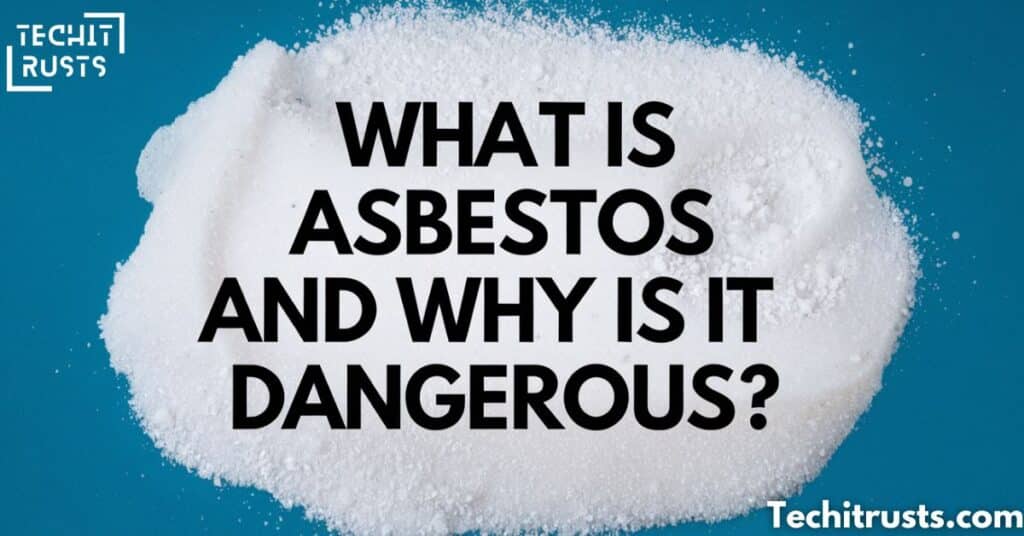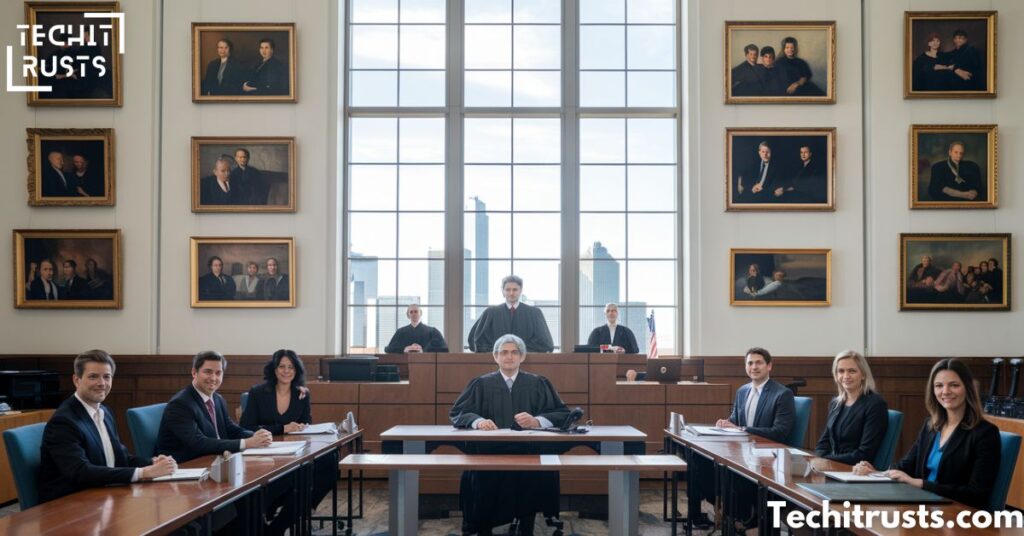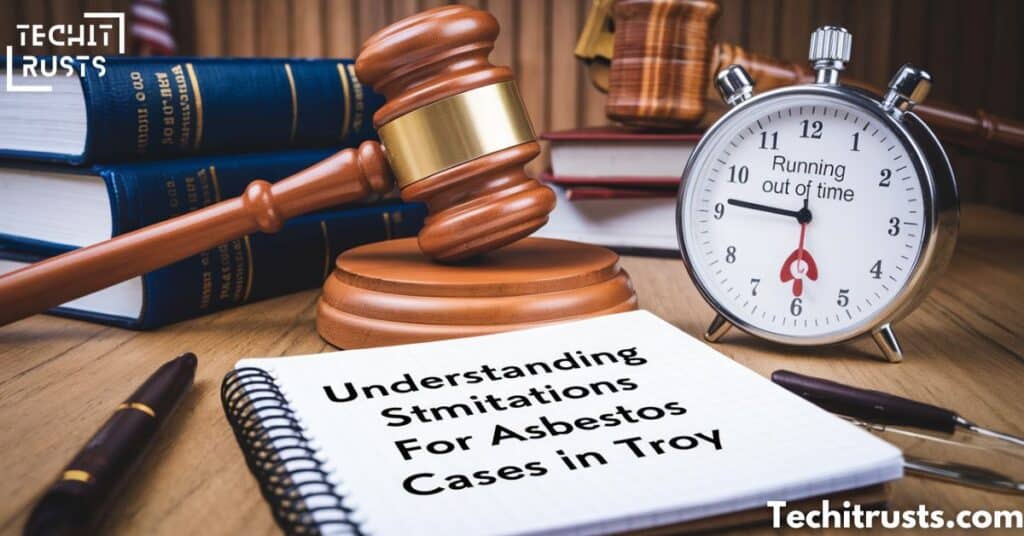Asbestos exposure remains a significant public health concern, particularly in areas like Troy, where industrial activities have historically heightened the risk of exposure. Understanding the intricacies of the Troy Asbestos Legal Question and the legal landscape surrounding asbestos-related diseases, such as mesothelioma, is crucial for victims and their families.
This comprehensive guide aims to equip readers with essential insights regarding legal options available for asbestos victims in Troy, including the process of filing claims, identifying responsible parties, and navigating the complexities of the asbestos legal framework.
What Is Asbestos and Why Is It Dangerous?

Asbestos is a naturally occurring mineral known for its remarkable heat resistance and durability. Once widely utilized in construction and manufacturing, asbestos has now gained notoriety due to its severe health risks. Prolonged exposure to asbestos fibers can lead to several serious conditions, including:
Health Risks Associated with Asbestos Exposure
- Mesothelioma: This rare and aggressive cancer primarily affects the lining of the lungs, known as pleural mesothelioma, and can also manifest in the abdomen (peritoneal mesothelioma). It is often diagnosed decades after initial exposure.
- Asbestosis: A chronic lung disease caused by the inhalation of asbestos fibers, leading to lung scarring and respiratory issues. Symptoms can take years to manifest, complicating diagnosis and treatment.
- Lung Cancer: Increased risk of developing lung cancer, especially among individuals who smoke and have been exposed to asbestos. The combination of smoking and asbestos exposure significantly elevates the risk.
The dangers of asbestos exposure arise from its fibrous nature. When asbestos-containing materials are disturbed, tiny fibers can become airborne and inhaled. Once in the lungs, these fibers can cause inflammation, scarring, and, ultimately, cancer.
Key Facts about Asbestos
- Historical Use: Asbestos was commonly used in insulation, roofing, flooring, and even some automotive parts until the late 20th century.
- Regulation: Many countries, including the United States, have banned or strictly regulated the use of asbestos in construction and manufacturing due to its health risks.
- Latency Period: Diseases associated with asbestos exposure can take 20-50 years to develop, making early diagnosis challenging.
Common Sources of Asbestos Exposure in Troy
Troy has a rich industrial history that has contributed to asbestos exposure among its residents. Identifying common sources of exposure can help individuals understand their risk factors.
Local Industries Known for Asbestos Use
- Manufacturing Facilities: Factories in Troy, particularly those producing construction materials, automotive parts, and insulation products, frequently used asbestos.
- Power Plants: Asbestos was commonly utilized in power plants for insulation and fireproofing equipment.
- Shipyards: Workers involved in shipbuilding or repair often encountered asbestos in ship insulation and fireproofing materials.
Historical Buildings and Construction Sites
Many older buildings in Troy may still contain asbestos materials, including:
- Schools: Many educational institutions built before the 1980s may have asbestos in insulation, flooring, and ceiling tiles.
- Commercial Buildings: Older offices and commercial properties can also harbor asbestos, posing a risk during renovations or demolition.
Occupational Exposure
Certain professions have a higher risk of asbestos exposure, including:
- Construction Workers: Laborers involved in building renovations or demolitions may disturb asbestos-containing materials.
- Mechanics: Those working on older vehicles may come into contact with asbestos in brake linings and gaskets.
- Industrial Workers: Employees in factories that manufactured or used asbestos products are at heightened risk.
Table: Common Asbestos Exposure Sources in Troy
| Source | Description |
| Factories | Utilized asbestos in insulation and products. |
| Schools and Hospitals | Older buildings may still contain asbestos. |
| Residential Properties | Homes built before the 1980s likely contain asbestos. |
| Shipyards | Asbestos used for insulation on ships. |
The Legal Framework for Asbestos Cases in Troy
Navigating the legal landscape surrounding asbestos cases can be complex. Understanding the legal framework is vital for victims seeking compensation.
Federal and State Laws Governing Asbestos
In the United States, various laws regulate the use of asbestos and provide pathways for victims to seek compensation. Key legislation includes:
- Toxic Substances Control Act (TSCA): Regulates the use of asbestos and other hazardous materials.
- Asbestos Hazard Emergency Response Act (AHERA): Mandates inspection and management of asbestos in public buildings.
- State Laws: Each state has its own laws regarding asbestos litigation, including statutes of limitations and legal procedures.
Legal Avenues for Asbestos Victims
Victims of asbestos exposure in Troy can pursue several legal avenues:
- Personal Injury Lawsuits: Individuals diagnosed with an asbestos-related disease can file a lawsuit against responsible parties, seeking compensation for medical expenses, lost wages, and pain and suffering.
- Wrongful Death Claims: Family members can file a wrongful death claim if a loved one died due to an asbestos-related disease, seeking damages for loss of companionship and funeral expenses.
- Asbestos Trust Funds: Many companies that manufactured asbestos products have established trust funds to compensate victims after declaring bankruptcy. Victims can file claims against these funds for compensation.
Overview of Asbestos Claims Process
- Initial Consultation: Victims should consult with an experienced attorney to discuss their case and understand their legal options.
- Gathering Evidence: Documenting exposure history, medical records, and any relevant witness statements is crucial.
- Filing a Claim: The attorney will prepare and file the necessary legal documents with the appropriate court or trust fund.
- Discovery Process: Both parties will exchange evidence, including depositions from witnesses and expert testimony.
- Settlement or Trial: Many cases settle out of court, but if a fair agreement cannot be reached, the case may proceed to trial.
Key Facts You Should Know About Troy Asbestos Cases

Awareness of key facts surrounding asbestos cases can significantly impact your legal journey and preparedness.
Asbestos Case Statistics in Troy
- Incidence Rate: Troy has experienced a rising number of reported mesothelioma cases, underscoring the need for legal action.
- Demographics: A significant percentage of cases involve individuals who worked in construction or manufacturing industries.
Timeline for Claims
- Statute of Limitations: Understanding the statute of limitations is critical. In Michigan, victims generally have three years from the date of diagnosis to file a claim. Delaying can jeopardize your ability to seek compensation.
Additional Considerations
- Proving Causation: Establishing a clear link between exposure and diagnosis is crucial for a successful claim.
- Documentation: Keeping meticulous records of medical treatments, workplace environments, and any correspondence related to your exposure will strengthen your case.
Fact Box: Key Statistics on Asbestos Exposure in Troy
| Statistic | Value |
| Annual Mesothelioma Cases | Approximately 30-50 cases reported yearly |
| Occupations with Highest Exposure | Construction and manufacturing workers |
| Average Age at Diagnosis | 60-70 years |
How Asbestos Exposure Leads to Legal Claims
The pathway from asbestos exposure to legal claims involves establishing a clear link between exposure and disease. Victims must demonstrate that:
- Exposure Occurred: Documenting exposure history is vital, including workplace environments and product use.
- Health Effects: Medical records must indicate a diagnosis of an asbestos-related disease, such as mesothelioma, asbestosis, or lung cancer.
- Identifying Responsible Parties: Knowing who to hold accountable is key; this could be employers, manufacturers, or property owners.
Documenting Exposure History
Victims should maintain detailed records of their exposure history, which may include:
- Employment Records: Contracts, pay stubs, or any documents proving the duration of employment in high-risk industries.
- Medical Records: Diagnosis details, treatment plans, and medical evaluations that confirm an asbestos-related disease.
- Documentation of Work Environments: Photographs, memos, or other records that indicate where exposure occurred and the materials involved.
Identifying Responsible Parties in Troy Asbestos Cases

Determining who is liable for asbestos exposure is crucial in pursuing compensation. Potential responsible parties include:
Asbestos Product Manufacturers
Companies that produced or sold asbestos-containing products may be held liable. They can be sued if:
- They failed to warn consumers about the dangers of their products.
- They did not take reasonable steps to ensure safety in manufacturing.
Employers
If an employer failed to provide a safe work environment or did not inform employees about asbestos risks, they may be liable for damages. Factors to consider include:
- Negligence: Did the employer provide adequate training and protective equipment?
- Safety Regulations: Were safety protocols followed according to state and federal laws?
Property Owners
If exposure occurred due to unsafe conditions in residential or commercial properties, property owners could be held responsible. Key considerations include:
- Knowledge of Asbestos: Did the owner know about the presence of asbestos and fail to inform tenants or workers?
- Maintenance and Repairs: Did the property owner conduct necessary maintenance to remove or contain asbestos?
Table: Potentially Responsible Parties in Asbestos Cases
| Responsible Party | Possible Liabilities |
| Asbestos Manufacturers | Failure to warn about dangers; defective products. |
| Employers | Negligence in providing a safe work environment. |
| Property Owners | Failing to disclose asbestos presence. |
Steps to Take After Diagnosis
Receiving a diagnosis of an asbestos-related disease can be overwhelming. Here are crucial steps to take:
Consult a Medical Professional
Seek treatment from specialists who understand asbestos-related diseases. They can guide you through treatment options and provide necessary medical documentation for your claim.
Document Your Case
Collect all relevant documents, including:
- Medical records detailing your diagnosis and treatment.
- Employment records highlighting your exposure history.
- Any communications regarding your exposure.
Contact an Experienced Attorney

A lawyer specializing in asbestos litigation can help you navigate the complexities of filing a claim, ensuring you understand your rights and options.
Explore Support Resources
Victims and their families may benefit from emotional support services, including:
- Support Groups: Connecting with others facing similar challenges can provide comfort and understanding.
- Counseling Services: Professional counseling may help individuals cope with the emotional toll of an asbestos diagnosis.
Types of Asbestos-Related Diseases Recognized in Troy
Understanding the various asbestos-related diseases is essential for victims seeking compensation. Here are some of the most common:
Mesothelioma
A highly aggressive cancer primarily caused by asbestos exposure, mesothelioma affects the linings of the lungs, heart, or abdomen. Symptoms can include:
- Chest pain
- Shortness of breath
- Persistent cough
Asbestosis
This chronic lung disease results from prolonged asbestos exposure, leading to scarring of lung tissue. Common symptoms include:
- Chronic cough
- Shortness of breath
- Fatigue
Lung Cancer
Lung cancer, particularly among smokers who have been exposed to asbestos, is a significant concern. Symptoms may include:
- Coughing up blood
- Chest pain
- Unexplained weight loss
Other Cancers
Research continues into the links between asbestos exposure and other cancers, including:
- Laryngeal cancer
- Ovarian cancer
- Gastrointestinal cancers
Finding the Right Attorney for Asbestos Cases
Choosing the right legal representation can significantly impact the outcome of your case. Here’s how to find an attorney suited to your needs:
Key Qualities to Look For
- Experience: Look for attorneys with a proven track record in handling asbestos cases.
- Reputation: Research online reviews and seek referrals from trusted sources.
- Specialization: Ensure the attorney focuses on personal injury and asbestos litigation specifically.
Initial Consultations
Schedule consultations with potential attorneys to discuss your case. Prepare a list of questions, including:
- What is your experience with asbestos cases?
- What is your approach to handling claims?
- How do you charge for your services (contingency fees, hourly rates)?
Compensation Options for Asbestos Victims in Troy
Victims of asbestos exposure may seek various forms of compensation, depending on their situation. Understanding these options is crucial for pursuing justice.
Types of Compensation Available
- Economic Damages: These cover quantifiable losses, including medical expenses, lost wages, and rehabilitation costs.
- Non-Economic Damages: Compensation for intangible losses, such as pain and suffering, emotional distress, and loss of companionship.
- Punitive Damages: In some cases, courts may award punitive damages if the defendant’s actions were particularly egregious.
Asbestos Trust Fund Claims
Many asbestos manufacturers have established trust funds to compensate victims. The process typically involves:
- Determining Eligibility: Confirming that your exposure is linked to a company that has set up a trust fund.
- Filing a Claim: Submitting necessary documentation, including medical records and proof of exposure.
- Review Process: The fund administrators will review your claim, and if approved, you may receive compensation without going to court.
Case Study: Successful Asbestos Claim
In a notable case in Troy, a factory worker diagnosed with mesothelioma successfully sued an asbestos product manufacturer. The court awarded $2.5 million in damages, considering medical expenses, loss of income, and emotional distress.
This case highlights the importance of documenting exposure history and having experienced legal representation.
Navigating Asbestos Trust Fund Claims in Troy

Trust funds are a critical resource for victims seeking compensation without the lengthy court process. Understanding how to navigate these claims is essential.
What Are Asbestos Trust Funds?
Asbestos trust funds are established by companies that have declared bankruptcy due to asbestos-related lawsuits. These funds are set up to compensate victims who were harmed by their products. Each trust has its own rules and eligibility criteria.
How to File a Claim
- Identify the Trust: Determine which trust fund your claim falls under based on your exposure to specific products.
- Gather Documentation: Collect medical records, work history, and any other documents proving exposure to asbestos.
- Submit Your Claim: Complete the trust’s application process, ensuring all information is accurate and thorough.
- Await Response: The trust will review your claim and may request additional information before making a decision.
Challenges in Trust Fund Claims
- Complex Procedures: Each trust has unique filing requirements and deadlines, which can be challenging to navigate.
- Documentation Requirements: Gathering comprehensive documentation is crucial, as incomplete submissions can delay claims.
The Role of Expert Witnesses in Asbestos Cases
Expert witnesses can play a vital role in asbestos litigation, providing essential testimony and supporting evidence. Their contributions may include:
Types of Expert Witnesses
- Medical Experts: Physicians specializing in asbestos-related diseases can provide testimony regarding the diagnosis and prognosis.
- Industrial Hygiene Experts: These professionals assess exposure levels and the safety of work environments.
- Economic Experts: They can quantify the financial impact of asbestos-related diseases, including lost wages and medical costs.
Impact of Expert Testimony
Expert testimony can strengthen a case by providing:
- Credible Evidence: Objective evidence supports claims of exposure and health impacts.
- Clarification of Complex Issues: Experts can explain technical concepts to judges and juries, enhancing their understanding of the case.
Common Challenges and Solutions in Asbestos Litigation
Navigating the legal landscape of asbestos litigation can present several challenges. Understanding these challenges and potential solutions can empower victims in their pursuit of justice.
Common Challenges
- Proving Causation: Establishing a direct link between asbestos exposure and a diagnosed disease can be complex. Victims may struggle to provide sufficient evidence.
- Identifying Responsible Parties: In cases involving multiple employers or manufacturers, determining liability can be difficult.
- Time Constraints: The statute of limitations can pose a challenge, as victims may need to act quickly after diagnosis.
Solutions to Overcome Challenges
- Thorough Documentation: Keeping meticulous records of exposure history, medical treatment, and relevant communications can strengthen a case.
- Expert Legal Guidance: Consulting with experienced attorneys can provide invaluable insights and strategies for overcoming obstacles in litigation.
- Utilizing Support Resources: Victims can benefit from support groups, counseling, and legal aid organizations to navigate the emotional and legal complexities of their cases.
Understanding Statutes of Limitations for Asbestos Cases in Troy

The statute of limitations refers to the time limit within which a legal claim must be filed. Understanding these deadlines is crucial for victims of asbestos exposure.
Michigan Statutes of Limitations
In Michigan, the statute of limitations for filing asbestos-related claims typically includes:
- Personal Injury Claims: Victims generally have three years from the date of diagnosis to file a claim.
- Wrongful Death Claims: Family members have three years from the date of death to initiate legal action.
Importance of Timely Action
Failure to file within the statute of limitations can result in losing the right to pursue compensation. Victims should act promptly and consult with an attorney as soon as they receive a diagnosis.
How Court Decisions Impact Asbestos Legal Outcomes in Troy
Court decisions play a significant role in shaping the outcomes of asbestos litigation. Understanding these impacts is crucial for victims.
Influential Cases
Landmark cases often set precedents that affect future litigation. For instance:
- Increased Damages Awards: Some cases have resulted in substantial damage awards, influencing how courts approach future asbestos claims.
- Defendant Liability: Rulings regarding manufacturers’ responsibilities can set new legal standards for accountability.
Current Legal Trends
- Shift Toward Victim Compensation: Courts are increasingly recognizing the severe impacts of asbestos exposure, resulting in higher compensation awards for victims.
- Emphasis on Accountability: Legal decisions may emphasize the importance of holding companies accountable for their role in exposing workers and consumers to asbestos.
Mesothelioma Lawsuits vs. Other Asbestos Claims in Troy
While mesothelioma lawsuits are the most recognized form of asbestos litigation, various types of claims exist. Understanding the differences can help victims make informed decisions.
Types of Asbestos Claims
- Mesothelioma Lawsuits: Specifically address claims related to mesothelioma diagnosis and related expenses.
- Asbestosis Claims: Focus on chronic lung diseases resulting from asbestos exposure.
- Lung Cancer Lawsuits: Address claims related to lung cancer due to asbestos exposure, often involving smokers.
Key Differences
- Diagnostic Criteria: Different types of claims have distinct medical criteria and documentation requirements.
- Compensation Amounts: Mesothelioma cases often result in higher compensation due to the severity and aggressiveness of the disease.
How to Prove Asbestos Exposure in Legal Cases
Proving asbestos exposure is a critical component of any legal claim. Victims must establish a clear link between exposure and their diagnosed disease.
Steps to Prove Exposure
- Gather Evidence: Collect employment records, medical documentation, and any other relevant materials.
- Document Work History: Outline job titles, employers, and specific roles involving potential asbestos exposure.
- Identify Products: List any known asbestos-containing products used during employment or in residential settings.
Importance of Expert Testimony
Engaging experts can enhance a victim’s ability to prove exposure. Medical professionals and industrial hygienists can provide testimony regarding:
- Exposure Levels: Assessing the extent of exposure based on job duties and working conditions.
- Health Impact: Explaining how exposure led to specific health issues.
Troy’s Resources and Assistance for Asbestos Victims
Victims of asbestos exposure in Troy can access various resources and support systems to aid their journey.
Local Support Organizations
- Mesothelioma Support Groups: Connecting with others facing similar diagnoses can provide emotional support and shared experiences.
- Legal Aid Services: Organizations offering legal assistance to those navigating the complexities of asbestos litigation.
Educational Resources
- Webinars and Workshops: Many organizations offer educational programs to inform victims about their rights and legal options.
- Online Resources: Websites dedicated to asbestos awareness can provide valuable information on support services and legal guidance.
Emotional Support Services
Victims may benefit from professional counseling and therapy to cope with the emotional toll of an asbestos diagnosis. Local mental health organizations can offer services tailored to individuals facing serious health challenges.
Future Trends in Troy Asbestos Litigation
The landscape of asbestos litigation is continuously evolving. Understanding potential future trends can inform victims and their families about what to expect.
Legislative Changes
Potential changes in laws regulating asbestos exposure and litigation could impact future claims. Advocacy groups continue to push for stricter regulations and protections for workers.
Increased Awareness
As public awareness about asbestos-related diseases grows, victims may find increased support and resources available. Educational campaigns can help empower individuals to seek legal recourse.
Advances in Medical Research
Ongoing research into asbestos-related diseases may lead to better treatment options and understanding of exposure risks. This knowledge can strengthen future litigation by providing clearer evidence linking exposure to health outcomes.
Frequently Asked Questions (FAQs)
What should I do if I have a Troy asbestos legal question?
If you have a legal question regarding asbestos exposure, consult an experienced attorney who specializes in asbestos litigation. They can provide guidance tailored to your situation.
How can I determine if I have a valid asbestos claim in Troy?
To determine if you have a valid claim, consider factors such as your exposure history, diagnosis of an asbestos-related disease, and the potential responsible parties.
What is the statute of limitations for filing an asbestos lawsuit in Troy?
In Michigan, the statute of limitations for personal injury claims related to asbestos exposure is generally three years from the date of diagnosis.
What types of compensation can I receive from an asbestos lawsuit in Troy?
Victims may be eligible for economic damages, non-economic damages, and in some cases, punitive damages.
How can I find the right attorney for an asbestos case in Troy?
Look for an attorney with experience in asbestos litigation, a strong reputation, and specialization in personal injury law. Schedule initial consultations to assess compatibility.
What are the common challenges in asbestos legal cases in Troy?
Common challenges include proving causation, identifying responsible parties, and navigating complex legal processes. Having expert legal guidance can help overcome these obstacles.
How does the process of filing an asbestos claim or lawsuit work in Troy?
The process generally involves consulting an attorney, gathering evidence, filing a claim, going through the discovery process, and possibly settling or proceeding to trial.
Conclusion
If you or a loved one has been affected by asbestos exposure, it’s vital to take action. Consult with an attorney who specializes in asbestos litigation, document your exposure, and explore the available resources.
The journey may be challenging, but you have the right to seek compensation and justice for the suffering caused by asbestos-related diseases.

Ashi is the site admin for “techitrusts.com” and specializes in writing within the journal category. If you need more detailed information about his background or work, feel free to ask!